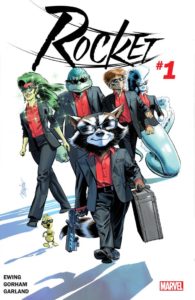 Rocket #1 — Writer: Al Ewing; Art: Adam Gorham; Colors: Michael Garland
Rocket #1 — Writer: Al Ewing; Art: Adam Gorham; Colors: Michael Garland
Guardians of the Galaxy: Mother Entropy #2 — Writer: Jim Starlin; Pencils: Al Davis; Inks: Mark Farmer; Colors: Matt Yacky
Star Wars: The Screaming Citadel #1 (of 5) — Writer: Kieron Gillen; Art: Marco Checchetto; Colors: Andres Mossa
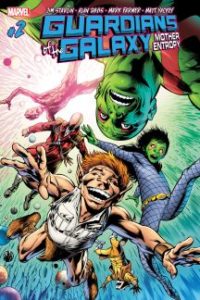 Zombies Assemble #1 — Writer/Artist: Yusaku Komiyama; Script: Jim Zub
Zombies Assemble #1 — Writer/Artist: Yusaku Komiyama; Script: Jim Zub
Secret Warriors #1 — Writer: Matthew Rosenberg; Art: Javier Garron; Colors: Israel Silva
Marvel first issues: Rocket because, duh, hot movie, and Al Ewing turns out to be a good choice as writer: he says on the editorial page that he’s doing “heists in space,” and so he is, with an omniscient hard-boiled 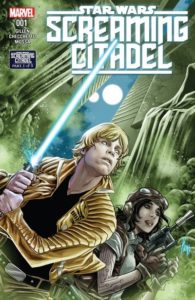 narrator and an intergalactic Ocean’s Eleven; what he doesn’t say is that this is also a love letter to late-’80s/early-90s Chris Claremont Excalibur comics, with one of their villains, a minor-but-memorable member of the supporting cast, and a lot of that title’s rollicking British stiff-upper-lip farce. Rocket fans from the Guardians movie should like this just fine. GOTG: Mother Entropy #2 continues last week’s Jim Starlin-written mini-series; it’s pretty standard (involving one of those “everybody faces their greatest phobias” plots that writers use to build character, and, no surprise, acting as a lead-in to another upcoming Starlin project with “infinity” in its title), but does have
narrator and an intergalactic Ocean’s Eleven; what he doesn’t say is that this is also a love letter to late-’80s/early-90s Chris Claremont Excalibur comics, with one of their villains, a minor-but-memorable member of the supporting cast, and a lot of that title’s rollicking British stiff-upper-lip farce. Rocket fans from the Guardians movie should like this just fine. GOTG: Mother Entropy #2 continues last week’s Jim Starlin-written mini-series; it’s pretty standard (involving one of those “everybody faces their greatest phobias” plots that writers use to build character, and, no surprise, acting as a lead-in to another upcoming Starlin project with “infinity” in its title), but does have 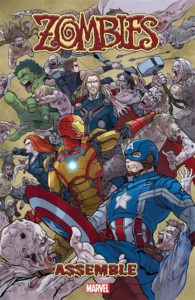 the advantage of the solid old-school Davis/Farmer art team (Davis, in a nice random connection, having been the artist and co-creator on those almost-thirty-year-old Excalibur comics…). Star Wars: The Screaming Citadel is by Kieron Gillen, the writer on the main Star Wars title; set right after the first movie, it teams up Luke and Gillen’s Doctor Aphra character as they chase after an ancient Jedi artifact, and it’s as atmospheric and briskly-paced as a Saturday-afternoon serial. Zombies Assemble is a reprint of the Japanese Yusaku Komiyama manga Avengers series from a couple years ago, and it’s a well-told set-
the advantage of the solid old-school Davis/Farmer art team (Davis, in a nice random connection, having been the artist and co-creator on those almost-thirty-year-old Excalibur comics…). Star Wars: The Screaming Citadel is by Kieron Gillen, the writer on the main Star Wars title; set right after the first movie, it teams up Luke and Gillen’s Doctor Aphra character as they chase after an ancient Jedi artifact, and it’s as atmospheric and briskly-paced as a Saturday-afternoon serial. Zombies Assemble is a reprint of the Japanese Yusaku Komiyama manga Avengers series from a couple years ago, and it’s a well-told set- up involving the movie lineup battling an outbreak of the undead; Japanese zombies are suitably creepy, and it’s interesting that the one character who doesn’t quite seem to work is Cap, who of course spent a good portion of his origin years battling “The Japs” when he wasn’t punching Hitler…. Secret Warriors is an Inhumans Secret Empire tie-in, but don’t run off just yet: it’s got Ms. Marvel, Moon Girl (and Devil Dinosaur), Quake and Karnak as resistance fighters, and it’s surprisingly readable (Rosenberg won me over near the end with a bit of byplay between Moon Girl and Karnak); fans of any of the lead characters will want this, because they’re all handled well here.
up involving the movie lineup battling an outbreak of the undead; Japanese zombies are suitably creepy, and it’s interesting that the one character who doesn’t quite seem to work is Cap, who of course spent a good portion of his origin years battling “The Japs” when he wasn’t punching Hitler…. Secret Warriors is an Inhumans Secret Empire tie-in, but don’t run off just yet: it’s got Ms. Marvel, Moon Girl (and Devil Dinosaur), Quake and Karnak as resistance fighters, and it’s surprisingly readable (Rosenberg won me over near the end with a bit of byplay between Moon Girl and Karnak); fans of any of the lead characters will want this, because they’re all handled well here.
 X-Men: Blue #3 — Writer: Cullen Bunn; Art: Jorge Molina and Ray-Anthony Height; Colors: Matt Milla
X-Men: Blue #3 — Writer: Cullen Bunn; Art: Jorge Molina and Ray-Anthony Height; Colors: Matt Milla
Weapon X # 3 — Writer: Greg Pak; Pencils: Greg Land and Ibraim Roberson; Inks: Jay Leisten and Ibraim Roberson; Colors: Frank D’Armata
Black Panther and the Crew #2 — Writers: Ta-Nehisi Coates and Yona Harvey; Pencils: Butch Guice with Mack Chater; Inks: Scott Hanna with Chater; Colors: Dan Brown
 America #3 — Writer: Gabby Rivera; Pencils: Joe Quinones with Stacy Lee; Inks: Joe Rivera with Stacy Lee; Colors: Jose Villarrubia with Jordan Gibson
America #3 — Writer: Gabby Rivera; Pencils: Joe Quinones with Stacy Lee; Inks: Joe Rivera with Stacy Lee; Colors: Jose Villarrubia with Jordan Gibson
A quartet of books still early in their runs: X-Men: Blue gets some mileage out of playing off its time-tossed ’70s original-teen X-Men against ’90s bad guys like Bastion, while Weapon X shoots for the gritty-antihero crowd, with Sabertooth, Domino and Wolverine now teamed up against the Terminator II-like androids wielded by 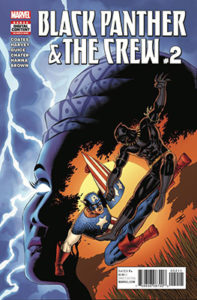 some shadowy organization looking to kidnap them; with Pak and Land as creators, this is very high-end standard-superhero fare. Black Panther and the Crew is also still in team-building mode; this issue is mostly Ororo Munroe in Harlem, and, while it’s set in the past, is meant to complement the Storm/Panther stuff going on in Coates’s main Black Panther title; fans of that long-time X-Woman should especially appreciate this story.
some shadowy organization looking to kidnap them; with Pak and Land as creators, this is very high-end standard-superhero fare. Black Panther and the Crew is also still in team-building mode; this issue is mostly Ororo Munroe in Harlem, and, while it’s set in the past, is meant to complement the Storm/Panther stuff going on in Coates’s main Black Panther title; fans of that long-time X-Woman should especially appreciate this story. 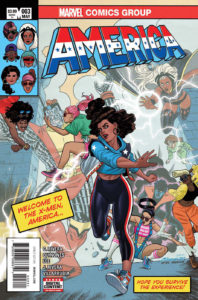 America has its heroine pin-balling through time and meeting up with, in another of those random connections, Storm (but in her punk/mohawk phase). It’s still trying to find its voice, and I think it’s going to be in its heroine’s kick-ass confidence, which shines through a couple of times, especially in the modern-day sequence at the end; if they can decide just how they’re going to leverage the political implications of a Chicana with that name into a power source, they might be able to get something good going here….
America has its heroine pin-balling through time and meeting up with, in another of those random connections, Storm (but in her punk/mohawk phase). It’s still trying to find its voice, and I think it’s going to be in its heroine’s kick-ass confidence, which shines through a couple of times, especially in the modern-day sequence at the end; if they can decide just how they’re going to leverage the political implications of a Chicana with that name into a power source, they might be able to get something good going here….
 Avengers #7 — Writers: Mark Waid and Jeremy Whitley; Art: Phil Noto; Colors: Mike del Mundo with Marco D’Alfonso
Avengers #7 — Writers: Mark Waid and Jeremy Whitley; Art: Phil Noto; Colors: Mike del Mundo with Marco D’Alfonso
Amazing Spider-Man #27 — Writer: Dan Slott; Pencils: Stuart Immonen; Inks: Wade von Grawbadger; Colors: Marte Gracia
Silver Surfer #11 — Writer: Dan Slott; Art: Michael Allred; Colors: Laura Allred
 Avengers is a good sampler issue, a done-in-one tale with the Victor Von Doom Iron Man asking the team for help; Waid uses the new teen Wasp, who sees him as an alpha science geek and peppers him with questions, as a buffer to keep the others from just hitting him first, and Noto’s dense, color-rich art works particularly well with a couple of the mystical-battle effects. Amazing Spider-Man is in the middle of a fight with the Green Goblin, who’s taken over Silver Sable’s vaguely-Eastern-European nation, Symkaria, so that Sable and
Avengers is a good sampler issue, a done-in-one tale with the Victor Von Doom Iron Man asking the team for help; Waid uses the new teen Wasp, who sees him as an alpha science geek and peppers him with questions, as a buffer to keep the others from just hitting him first, and Noto’s dense, color-rich art works particularly well with a couple of the mystical-battle effects. Amazing Spider-Man is in the middle of a fight with the Green Goblin, who’s taken over Silver Sable’s vaguely-Eastern-European nation, Symkaria, so that Sable and 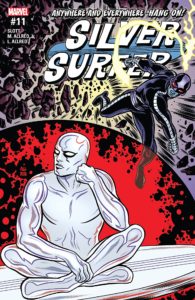 Spidey have to flout international law, and S.H.I.E.L.D., to come to the rescue; it’s the usual well-done serial-superhero storytelling. Silver Surfer has been offering a number of one-issue stories that tie into a larger timeline involving the Surfer/Dawn relationship, with a number of hints of rocky times to come, and seems to be gearing up for that soon (you always wonder when a comic approaches a multiple of six — #12, #18, etc.– because that’s often the cutoff for a trade collection, and a logical place to end a story); the Allred art, and the way Slott’s script plays to its trippy strengths, always make it worth having.
Spidey have to flout international law, and S.H.I.E.L.D., to come to the rescue; it’s the usual well-done serial-superhero storytelling. Silver Surfer has been offering a number of one-issue stories that tie into a larger timeline involving the Surfer/Dawn relationship, with a number of hints of rocky times to come, and seems to be gearing up for that soon (you always wonder when a comic approaches a multiple of six — #12, #18, etc.– because that’s often the cutoff for a trade collection, and a logical place to end a story); the Allred art, and the way Slott’s script plays to its trippy strengths, always make it worth having.
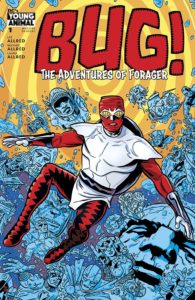 Bug! #1 — Storytellers: Lee and Michael Allred; Colors: Laura Allred
Bug! #1 — Storytellers: Lee and Michael Allred; Colors: Laura Allred
Shade the Changing Girl #8 — Writer: Cecil Castellucci; Art: Marley Zircone with Ande Parks; Colors: Kelly Fitzpatrick
All-Star Batman #10 — Writer: Scott Snyder; Art: Rafael Albuquerque; Colors: Jordie Bellaire
Titans #11 — Story: Priest, Benjamin Percy and Dan Abnett; Writer: Dan Abnett; Pencils: Brett Booth; Inks: Norm Rapmund; Colors: Andrew Dalhouse with Carrie Strachan
 Bug!, the newest book from DC’s Gerard Way-led Young Animals imprint, is an Allred family affair, with art from Michael, script from brother Lee and coloring from wife Laura. It utilizes the Jack Kirby character from the New Gods comics, setting him on a quest involving lots of connections to other early-’70s DC Kirby books like Omac, Manhunter and, especially in this issue, the Simon/Kirby Sandman. You don’t need to know any of that stuff to enjoy the book, though: Michael Allred’s style has always been a throwback to that era, and its offbeat, joyous energy carries things along briskly, with enough philosophical bits about independence and fate to appeal both to the Young Animals’ high-school-age target audience and to the rest of us, too: if you’ve liked any of the other YA titles — or were a Vertigo fan back in
Bug!, the newest book from DC’s Gerard Way-led Young Animals imprint, is an Allred family affair, with art from Michael, script from brother Lee and coloring from wife Laura. It utilizes the Jack Kirby character from the New Gods comics, setting him on a quest involving lots of connections to other early-’70s DC Kirby books like Omac, Manhunter and, especially in this issue, the Simon/Kirby Sandman. You don’t need to know any of that stuff to enjoy the book, though: Michael Allred’s style has always been a throwback to that era, and its offbeat, joyous energy carries things along briskly, with enough philosophical bits about independence and fate to appeal both to the Young Animals’ high-school-age target audience and to the rest of us, too: if you’ve liked any of the other YA titles — or were a Vertigo fan back in 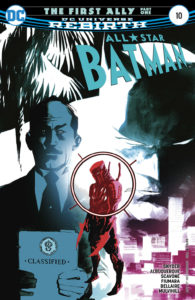 the day — this is a first issue worth picking up. Shade the Changing Girl, another in the Young Animals line, has a similar philosophical buzz, especially now that its main character (a bird-like alien from the planet Meta who’s possessed the body of a comatose teenage mean girl) has left her high-school hell and run off to the big city; the parts about striking out on your own, newly independent, and encountering a new urban milieu should resonate with a lot of late teens and early twenty-somethings, even the ones who don’t have a Madness Vest to help them out. All-Star Batman starts a new arc with writer Scott Snyder examining the father-son relationship between Bruce Wayne and Alfred Pennyworth; narrated by the more-than-butler, and told with appealingly-loose,
the day — this is a first issue worth picking up. Shade the Changing Girl, another in the Young Animals line, has a similar philosophical buzz, especially now that its main character (a bird-like alien from the planet Meta who’s possessed the body of a comatose teenage mean girl) has left her high-school hell and run off to the big city; the parts about striking out on your own, newly independent, and encountering a new urban milieu should resonate with a lot of late teens and early twenty-somethings, even the ones who don’t have a Madness Vest to help them out. All-Star Batman starts a new arc with writer Scott Snyder examining the father-son relationship between Bruce Wayne and Alfred Pennyworth; narrated by the more-than-butler, and told with appealingly-loose, 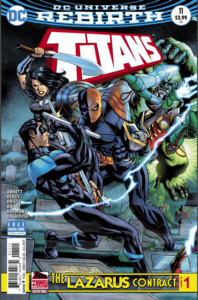 shadowy art by Rafael Albuquerque, it should make the legions of bat-fans happy while adding to the characters’ early mythos. Titans, finally, is worth noting because it’s the start of a Titans/Teen Titans/Deathstroke crossover, “The Lazarus Contract,” involving Slade wanting revenge for the death of his son Grant, the first Ravager, way back in the 1980 New Teen Titans #2; it looks like it’s meant to resolve that long-ago conflict, while combining the various teams in interesting ways: that, plus the last-page cliffhanger, which brings together two popular characters with the same name for the first time, should be enough to bring readers back for more.
shadowy art by Rafael Albuquerque, it should make the legions of bat-fans happy while adding to the characters’ early mythos. Titans, finally, is worth noting because it’s the start of a Titans/Teen Titans/Deathstroke crossover, “The Lazarus Contract,” involving Slade wanting revenge for the death of his son Grant, the first Ravager, way back in the 1980 New Teen Titans #2; it looks like it’s meant to resolve that long-ago conflict, while combining the various teams in interesting ways: that, plus the last-page cliffhanger, which brings together two popular characters with the same name for the first time, should be enough to bring readers back for more.
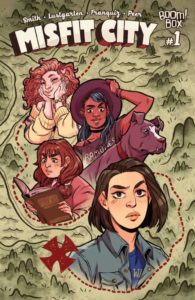 Misfit City #1 — Writers: Kirsten Smith andf Kurt Lustgarten; Art: Naomi Franquiz; Colors: Brittany Peer
Misfit City #1 — Writers: Kirsten Smith andf Kurt Lustgarten; Art: Naomi Franquiz; Colors: Brittany Peer
Mindbender #1 — Writer: James Pruett; Art: Federico de Luca
Regression #1 — Writer: Cullen Bunn; Art: Danny Luckert; Colors: Marie Enger
Renato Jones: Season Two: Freelancer #1 — Creator: Kaare Andrews
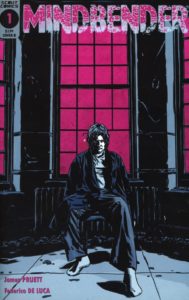 Rock Candy Mountain #2 — Writer/Artist: Kyle Starks; Colors: Chris Schweizer
Rock Candy Mountain #2 — Writer/Artist: Kyle Starks; Colors: Chris Schweizer
Shadows on the Grave #4 — Creator: Rich Corben
A.D.: After Death #3 (of 3) — Writer: Scott Snyder; Art: Jeff Lemire
Misfit City is yet another love letter to the ’80s, as a group of modern-day young women live in an Oregon town made famous by a movie from that period (it’s  called The Gloonies; gosh, I wonder what actual movie they could be parodying…?), deal with clueless tourists, and, inevitably, get swept up in an actual treasure hunt, complete with wrinkled old map; it’s got the partly-manga style, unspoken diversity, and brisk adventure-comic optimism of a lot of the other Boom! Box titles, from Lumberjanes to Backstagers to Jonesy. Mindbender starts with a seven-year-old at a county fair who manifests supernatural/mutant powers and accidentally kills his parents; he shuts down for 16
called The Gloonies; gosh, I wonder what actual movie they could be parodying…?), deal with clueless tourists, and, inevitably, get swept up in an actual treasure hunt, complete with wrinkled old map; it’s got the partly-manga style, unspoken diversity, and brisk adventure-comic optimism of a lot of the other Boom! Box titles, from Lumberjanes to Backstagers to Jonesy. Mindbender starts with a seven-year-old at a county fair who manifests supernatural/mutant powers and accidentally kills his parents; he shuts down for 16 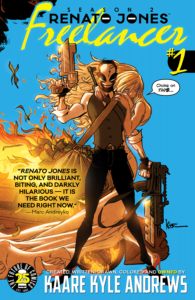 years and is confined to a mental institution, but now, partly spurred by an idealistic young psychology intern, he’s waking up, and shadowy government forces want to tap his power…. this is very well-traveled ground (it reads like the beginning of at least a dozen X-Men stories, among other things), but for a first issue it’s solidly constructed, and artist de Luca has an ink- and color-drenched style, something like Kelley Jones, that works well with the suspense and horror elements. Regression is a horror book, too, about a young adult who’s suffered from crawling-insect and rotted-corpse
years and is confined to a mental institution, but now, partly spurred by an idealistic young psychology intern, he’s waking up, and shadowy government forces want to tap his power…. this is very well-traveled ground (it reads like the beginning of at least a dozen X-Men stories, among other things), but for a first issue it’s solidly constructed, and artist de Luca has an ink- and color-drenched style, something like Kelley Jones, that works well with the suspense and horror elements. Regression is a horror book, too, about a young adult who’s suffered from crawling-insect and rotted-corpse  hallucinations his whole life, and undergoes past-life hypnosis to try to combat it; naturally, this awakens Things That Should Not Be Awakened. The art’s decent enough on the splattery bits, and the set-up’s good, so horror fans should check it out. Renato Jones: Season Two is the next arc featuring Kaare Andrews’s one-percenter-elite-battling vigilante; it’s not what you’d call subtle, and Andrews, an imaginative and energetic artist, could really use an actual writer to smooth out all the rough edges, but maybe it’s all that rage, DIY sloppiness and excess that make it a good fit for the Age of Trump (it’s got a last-
hallucinations his whole life, and undergoes past-life hypnosis to try to combat it; naturally, this awakens Things That Should Not Be Awakened. The art’s decent enough on the splattery bits, and the set-up’s good, so horror fans should check it out. Renato Jones: Season Two is the next arc featuring Kaare Andrews’s one-percenter-elite-battling vigilante; it’s not what you’d call subtle, and Andrews, an imaginative and energetic artist, could really use an actual writer to smooth out all the rough edges, but maybe it’s all that rage, DIY sloppiness and excess that make it a good fit for the Age of Trump (it’s got a last-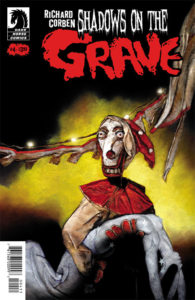 page development that indicates that maybe Andrews thinks that, too). Rock Candy Mountain continues its well-researched tale of the early-20th-century hobo lifestyle; between Starks’s kinetic, cartoony violence (look at the cover, up to the left there; as always, if you click on it you’ll get a bigger version) and all the fascinating bits of hobo lingo and mythology, it offers a refreshingly-unique story, without any costumes or spandex in sight. Shadows on the Grave continues Richard Corben’s horror anthology series; considering his long career, and intensely-personal style, you probably either want this immediately or don’t — but if you’ve never sampled
page development that indicates that maybe Andrews thinks that, too). Rock Candy Mountain continues its well-researched tale of the early-20th-century hobo lifestyle; between Starks’s kinetic, cartoony violence (look at the cover, up to the left there; as always, if you click on it you’ll get a bigger version) and all the fascinating bits of hobo lingo and mythology, it offers a refreshingly-unique story, without any costumes or spandex in sight. Shadows on the Grave continues Richard Corben’s horror anthology series; considering his long career, and intensely-personal style, you probably either want this immediately or don’t — but if you’ve never sampled 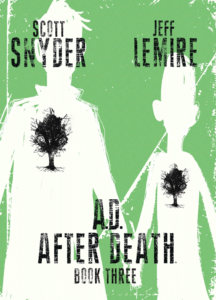 him before, you should, and this is a good example of his work. That leaves A.D.: After Death, the Scott Snyder/Jeff Lemire three-part comic/graphic novel: it’s got great production values, and an actual beginning/middle/ending story that’s a haunting sf mystery with a spinning-top ending (if you get that Inception reference) that fits it perfectly. All three issues are still available on the stands at a great price point, since each is 100 pages of oversized, beautifully and subtly-colored art and text for $5.99; you end up with a 300-page story for $18, less than four 32-pages-including-ads Marvel or DC books and a great deal by any measure.
him before, you should, and this is a good example of his work. That leaves A.D.: After Death, the Scott Snyder/Jeff Lemire three-part comic/graphic novel: it’s got great production values, and an actual beginning/middle/ending story that’s a haunting sf mystery with a spinning-top ending (if you get that Inception reference) that fits it perfectly. All three issues are still available on the stands at a great price point, since each is 100 pages of oversized, beautifully and subtly-colored art and text for $5.99; you end up with a 300-page story for $18, less than four 32-pages-including-ads Marvel or DC books and a great deal by any measure.



